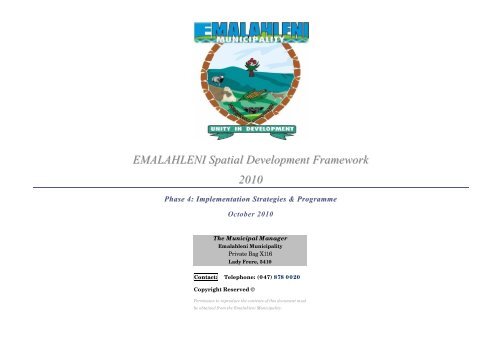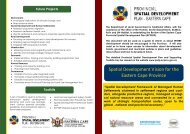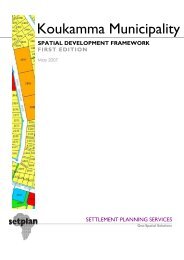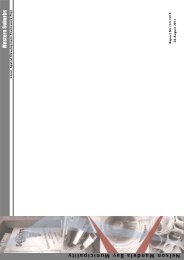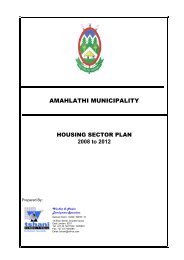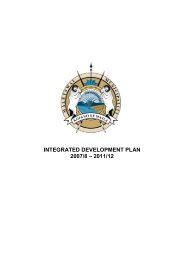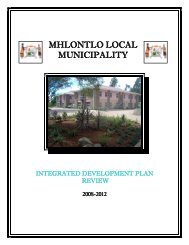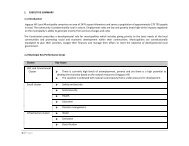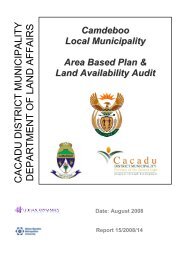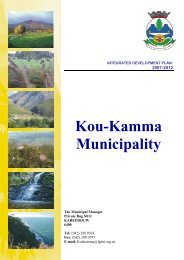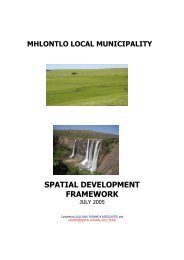Emalahleni Rural SDF_Phase 4.pdf - Provincial Spatial ...
Emalahleni Rural SDF_Phase 4.pdf - Provincial Spatial ...
Emalahleni Rural SDF_Phase 4.pdf - Provincial Spatial ...
Create successful ePaper yourself
Turn your PDF publications into a flip-book with our unique Google optimized e-Paper software.
EMALAHLENI <strong>Spatial</strong> Development Framework2010<strong>Phase</strong> 4: Implementation Strategies & ProgrammeOctober 2010The Municipal Manager<strong>Emalahleni</strong> MunicipalityPrivate Bag X116Lady Frere, 5410Contact: Telephone: (047) 878 0020Copyright Reserved ©Permission to reproduce the contents of this document mustbe obtained from the <strong>Emalahleni</strong> Municipality.
EMALAHLENI MUNICIPAL SPATIAL DEVELOPMENT FRAMEWORK October 20101. INTRODUCTIONThe Department of <strong>Rural</strong> Development and Land Reform conducted a miniauditand evaluation, which, together with the National IDP Assessment of2008, revealed that many municipalities have not been able to develop credible,comprehensive and purposeful <strong>Spatial</strong> Development Frameworks (<strong>SDF</strong>s), asrequired in terms of the Municipal Systems Act, No 32 of 2000.In addition, many <strong>SDF</strong>s were found to be un-strategic, giving no direction forgrowth and not responding to the need for integrated and sustainabledevelopment, particularly in the rural context. This problem was seen to becompounded by the lack of capacity to plan and implement plans inmunicipalities in peripheral and/or largely rural circumstances.As a result, the Department issued a tender for the development of rural-specific<strong>SDF</strong>s in selected municipalities in all 9 provinces, with the objective ofaddressing spatial, environmental and economic issues confrontingpredominantly rural areas.Following due process, the Department appointed a professional team led byUMHLABA Consulting Group (Pty) Ltd in April 2010, to assist the <strong>Emalahleni</strong>Municipality to review and compile a new <strong>SDF</strong> for its area of jurisdiction.The <strong>SDF</strong> is to be formulated in compliance with the requirements of Section26(e) of the Municipal Systems Act (Act 32 of 2000) and the Municipal Planning& Performance Management Regulations (R796/2001), read together with theWhite Paper on <strong>Spatial</strong> Planning and Land Use Management, 2001. In addition,the <strong>SDF</strong> will aim at incorporating the principles contained in Chapter 1 of theDevelopment Facilitation Act (No 67 of 1995).In addition to giving clear and specific direction with regards to ruraldevelopment issues, the <strong>SDF</strong> should provide a sound platform from which todevelop and implement an effective Land Use Management System within theMunicipality’s area of jurisdiction and, accordingly, clear guidelines to informland use management are key outputs of the project1.1 PURPOSE OF THIS REPORTThis report, the fourth and final in a series of reports that make up the final <strong>SDF</strong>document, is intended to identify basic strategies to implement the proposals ofthe <strong>SDF</strong> as well as to outline any specific projects and/or programmes that areseen as important to advance spatial planning, land use management and landdevelopment processes in <strong>Emalahleni</strong>. As such, this report sets out: -• Land Use Management Guidelines that are intended to guide the activities of the<strong>Emalahleni</strong> Municipality in managing spatial development as well as in its role asLand Use Regulator. These Guidelines include:o Specific Directive Principles in relation to key concerns for Land UseManagement, including (i) Achieving Densification in appropriatesettlements; (ii) The implementation of Housing/Human Settlementprojects in urban and rural settlements; and (iii) ensuring appropriate preplanningand land development management measures (such as linkinginfrastrcuture provision to development approvals);o A basic framework for categorising different forms and intensities ofsettlement and relating these to a typical Level of Service;o Information drawn from the Eastern Cape Biodiversity Management Plan(ECBMP) that provides direction on how to apply the directives of the Planin spatial planning and land use management in different LandManagement Class areas; ando A more detailed set of Land Use Management Guidelines (based on theGuidelines contained in the Chris Hani District <strong>Spatial</strong> DevelopmentFramework) to provide guidance and input on how to manage differentcategories of land use/settlement types.• Institutional Proposals on taking the <strong>Spatial</strong> Planning function forward and usingthe <strong>SDF</strong> as a tool for the purposes of the IDP; and• Proposed Priority Actions and Projects in relation to identified <strong>Spatial</strong> PlanningProgrammes2 | Page
EMALAHLENI MUNICIPAL SPATIAL DEVELOPMENT FRAMEWORK October 20101.2 STUDY AREAThe <strong>Emalahleni</strong> Municipal area falls under the jurisdiction the Chris HaniDistrict Municipality. It is bordered by the following Local Municipalities- Sakhisizwe LM (Chris Hani DM) to the east,- Intsika Yethu LM (Chris Hani DM) to the south,- Lukhanji LM (Chris Hani DM) to the south west,- Inkwanca LM (Chris Hani DM) to the west,- Maletswai LM (Ukhahlamba DM) to the north,- Senqu LM ((Ukhahlamba DM) to the north eastThe Municipality comprises the small urban areas of Lady Frere, Indwe andDordrecht, incorporating the surrounding rural areas of Woodehouse and GlenGrey to the east of Queenstown. The Municipal area extends over an area ofapproximately 3 440 square kilometers, includes some 200 rural villages andcomprises sixteen (16) wards.3 | Page
EMALAHLENI MUNICIPAL SPATIAL DEVELOPMENT FRAMEWORK October 20102. Land Use Management Guidelines2.1 INTRODUCTIONThe formulation of land use management guidelines is a legally requiredcomponent of a <strong>Spatial</strong> Development Framework.In complying with this requirement, it is important to be clear on what isunderstood by the term “land use management”, and therefore, how this istranslated into a set of usable guidelines, relevant to the Municipality and itsassigned roles and functions.The following excerpt from the White Paper on <strong>Spatial</strong> Planning and Land UseManagement (Dept Land Affairs, 2001) provides a broad definition of what, inessence, a Land Use Management System is expected to achieve in the newspatial planning system in South Africa: -“To implement a [<strong>Spatial</strong> Development Framework] it is clearly necessary… to have mechanisms inplace to encourage the desired types of land development. This makes the Municipal Systems Actterminology, land use management, appropriate, as it suggests a function that is broader than merelycontrolling development. [Therefore], the term land use management includes the followingactivities:• The regulation of land-use changes such as, for example, the rezoning of a property fromresidential to commercial use;• The regulation of ‘green fields’ land development, i.e. the development of previously undevelopedland;• The regulation of the subdivision and consolidation of land parcels;• The regulation of the regularization and upgrading process of informal settlements, neglected citycentres and other areas requiring such processes; and• The facilitation of land development through the more active participation of the municipality inthe land development process, especially through public-private partnerships.Land-use management has two main underlying rationales. The first is the widely felt resistance tothe idea of uncontrolled land development and the second is the commonly expressed wish byparticular sectors in society to promote various types of desirable land development.The resistance to uncontrolled development is motivated by a number of concerns: -• Environmental concerns: uncontrolled development of land can have adverse effects on naturalhabitats, cultural landscapes and air and water quality.• Health and safety concerns: uncontrolled development can lead to overcrowding and unsafebuilding construction. Certain land uses can also be detrimental to the health and safety ofneighbours.• Social control: the control of land uses and building types has long been a means of exertingsocial control, particularly through the exclusion of certain types of person, household oreconomic activity from certain areas through the application of particular development controlslimiting, for instance, plot sizes, plot coverage and home industries.• Efficiency of infrastructure provision and traffic management: increasingly it has become clearthat the where the granting of development permissions is not coupled with the provision ofadequate infrastructure and traffic management the consequences can be severe. Similarly, whereinfrastructure is provided, generally at high financial cost, without taking into account likely andrelevant land-use and settlement patterns the opportunity costs to society are very high.• Determination of property values for purposes of rating: the market value of land is the basis onwhich property valuation is determined and the extent and nature of the development permitted onthe land is a key factor in that determination.• Aesthetic concerns: the control of land development enables government to prescribe certaindesign parameters for buildings.The wish to promote desirable development is also driven by a number of different concerns:• The land development needs of the market seldom match precisely the social and political needs ofgovernment: government may well want to promote a type of land development in an area that themarket neglects. It then has to take certain steps to facilitate that development or provideincentives.• Investment promotion: changing the applicable land-use management instruments is often seen asa prerequisite for attracting certain types of investment to certain areas. This can take the form ofboth relaxing controls in those areas and increasing controls in other areas which might be morefavoured by the market. These strategies are likely to be linked to local economic developmentinitiatives”.2.2 LAND USE MANAGEMENT AND THE EMALAHLENIMUNICIPALITYWith due regard to the above, the setting of Land Use Management Guidelinesin a Local Municipal <strong>Spatial</strong> Development Framework poses some complexchallenges, given the fact that there is an absence of either a single or a suite ofenabling legislation that would permit the formulation of integrated land use4 | Page
EMALAHLENI MUNICIPAL SPATIAL DEVELOPMENT FRAMEWORK October 2010management schemes applicable across the extent of a so-called wall-to-wallLocal Municipality.Whilst it is clear in terms of the assignment of the function of MunicipalPlanning to Local Municipalities that these institutions are – in theory – to beregarded as the primary Land Use Regulators charged with spatial planningand land use management (that is, reviewing land development applicationsand overseeing land development processes, including settlement developmentand land use changes) in their areas of jurisdiction, the reality is that in areassuch as <strong>Emalahleni</strong> this does not happen (refer to the <strong>Phase</strong> 2 document formore on this).Therefore, the intention of these Land Use Management Guidelines in the caseof the <strong>Emalahleni</strong> <strong>SDF</strong> is to attempt to provide a set of “tools” that could beused – in tandem with existing legislation and Schemes – to assist, guide anddirect the activities of the Local Municipality in attempting to engender a morerigorous approach to land use management in both its urban and ruralconstituencies.A wholly new Land Use Management System is only likely to bepossible once the legal framework is in place but it is possible to setin place procedures and protocols based on adopted principlesrelating to best practice. This is the ultimate objective of theseguidelines.Accordingly, this section sets out some key elements to a more holisticapproach to land use management. These are noted as follows 1 : -• Firstly, in reflecting on the current land use management system(s) in place,a brief overview of the currently applicable legislation and relevant spatialplanning and land use management tools is provided;• Secondly, in considering the desired outcomes in relation to the settlementpattern and typical forms of land use arrangements found in <strong>Emalahleni</strong>proposed in this <strong>SDF</strong>, the importance of Land Use Management as an1NOTE: This chapter is substantially based on the Land Use Management Guidelines set out in theChris Hani D i s t r ic t S DF,which were formulated to respond to the current situation that prevails in all of the Local Municipalities in the district.activity that is central to achieving these outcomes and contributes directlyto economic and environmental sustainability is emphasized;• Thirdly, broad input is given on the need to manage relationships andformulate binding agreements and protocols on how to deal with land usemanagement issues in the Municipal area; and• Finally, in respect of the concern to ensure a more sustainable approach tourban and rural development, the following is set out: -o A proposed framework for categorizing different types ofsettlement and associating these with typical Levels ofService (LOS) provision is provided, based on previous work donefor Land Reform & Settlement Plans compiled for the Amathole andChris Hani District Municipalities, 2005;o Based on the guidelines suggested by the Eastern Cape BiodiversityConservation Plan, generic land use objectives are incorporated inrelation to the different land management classes identified in thePlan; ando In relation to the hierarchy of settlement set out in <strong>Phase</strong> 3, a broad setof guidelines is proposed that is based on the Guidelines set out in theChris Hani District <strong>SDF</strong>.2.3 CURRENT LEGAL INSTRUMENTS RELEVANT TO LAND USEMANAGEMENT IN EMALAHLENIThe area comprising the jurisdiction of the <strong>Emalahleni</strong> Municipality is acomplex, composite area comprising a variety of landscapes and land typesranging from formal, planned urban settlement (towns), informal settlement,and peri-urban and rural settlement (villages), as well as transformed, lessimpacted and almost pristine natural areas.As indicated, land use management across this variety of land forms is notundertaken in terms of a coherent and overarching or integrated land usemanagement system. In legal terms, land uses are subject to monitoring andregulation in terms of environmental laws that apply across the area but thatare, in reality, only enforced in certain areas (the formalised, urbansettlements).5 | Page
EMALAHLENI MUNICIPAL SPATIAL DEVELOPMENT FRAMEWORK October 2010Therefore, strictly speaking, land use management is only formally applied inthe proclaimed urban settlements (towns) of Lady Frere, Indwe and Dordrecht.In Lady Frere (comprising of the erven making up the town itself and itssurrounding commonage), the relevant legislation to be employed to carry outland use management is the so-called Transkei Townships Ordinance(Ordinance No. 33 of 1934) and the applicable Town Planning Scheme is knownas the “Standard Transkei Town Planning Scheme”.Figure 2.1: Land Use Management Legislation Applicable in <strong>Emalahleni</strong><strong>Emalahleni</strong> MunicipalityIn the towns of Indwe and Dordrecht, the relevant legislation to be employed isthe Cape <strong>Provincial</strong> Land Use Planning Ordinance (Ordinance No. 15 of 1985)and the relevant Town Planning Regulations applicable in terms of thatOrdinance.Because it remains in effect at present, the Development Facilitation Act (No.67 of 1995) may also be used to effect land development processes and,importantly, this Act may be employed in both urban and rural contexts.However, in the rural settlement areas (communal areas) any material changein land use or any land development process that might result in a change insettlement or land use in a rural area must first be approved by the relevantcommunity residing in the area in terms of procedures prescribed by theregulations made in terms of the Interim Protection of Informal Land RightsAct (Act No. 31 0f 1996, known as IPILRA). This Act does not distinguishbetween “communal” or “rural” land and other land or land held by the Stateand land held by individuals or the private sector.The Department of <strong>Rural</strong> Development & Land Reform oversees the InterimProcedures governing development decisions concerning state land in the socalledrural areas, which require the consent of the Minister of <strong>Rural</strong>Development & Land Reform as nominal owner of the land. The Act and theinterim procedures will remain in force until repealed.The Table below summarises the most notable laws applicable to land usemanagement in the <strong>Emalahleni</strong> Municipality at present: -LawCape <strong>Provincial</strong> Land Use PlanningOrdinance (Ordinance 15 of 1985)CommentThe Ordinance is used to regulatetownship establishment procedures,procedures relating to the subdivisionand consolidation of land, and therezoning of land.In terms of the Ordinance, a set ofstandard Town Planning SchemeRegulations is applicable inproclaimed towns within the districtthat do not have a standalone Scheme.6 | Page
EMALAHLENI MUNICIPAL SPATIAL DEVELOPMENT FRAMEWORK October 2010LawCommentLawCommentTranskei Townships Ordinance 33 of1934The Development Facilitation Act (No.67 of 1995)Less Formal Townships EstablishmentAct (No. 113 of 1991)The Ordinance is used to regulatetownship establishment procedures,procedures relating to the subdivisionand consolidation of land, and therezoning of land.In terms of the Ordinance, a standardTown Planning Scheme is applicablein proclaimed Lady Frere.The Act is far-reaching in establishinga new approach to spatial planningand land use management in SouthAfrica, which is based on theapplication of normative principlesrather than inflexible rules.Various land use managementprocedures can be carried out usingthe Act, including townshipestablishment, subdivision andconsolidation of land, and therezoning of land.The Act provides various measures forfacilitating development andprescribes time frames within whichadministrative actions must beundertaken as part of land usemanagement processes.The Act provides for the establishmentof a township where there is anestablished urgent need for asettlement to be formalized (in orderto provide services or housing, forexample).Permission to use the Act has to besought before any application fortownship establishment can bebrought.The National Water Act (No. 36 of1998)The Act provides that no person orauthority shall establish a townshipunless the Layout Plan or SiteDevelopment Plan indicates in a clearmanner (that is acceptable to theapproving authority) the maximumlevel likely to be reached byfloodwaters on an average once in 100years (i.e. the 1 in 100-year flood line).However, in practice, development issometimes permitted up to the 1 in 50-year flood line, as this was previouslythe norm. In addition, the Actprovides for a range of protective andpreventative measures against thepollution of wetlands, watercoursesand estuaries, coastlines/shorelinesetc. Finally, of importance for spatialplanning is the fact that the Act makesprovision for river flow managementand allows the Minister of WaterAffairs to regulate land-basedactivities that impact on stream flow.2.4 INTERIM PROCEDURES DIRECTING DEVELOPMENTDECISIONS IN COMMUNAL LAND AREASIn addition to the above, given the overwhelmingly rural nature of the ChrisHani district, it should be noted that land use management processes or spatialplanning that require any changes to be effected in a rural settlement area thataffects an existing community are subject to Interim Procedures applicable interms of the Interim Protection of Informal Land Rights Act (No. 31 of 1996 -IPILRA), which provides for the protection of informal rights to land.The Act does not distinguish between “communal” or “rural” land and otherland or land held by the State and land held by individuals or the private sector.7 | Page
EMALAHLENI MUNICIPAL SPATIAL DEVELOPMENT FRAMEWORK October 2010The Department of <strong>Rural</strong> Development & Land Reform oversees the InterimProcedures governing development decisions concerning state land in the socalledrural areas, which required the consent of the Minister of Land Affairs asnominal owner of the land. The Act and the interim procedures will remain inforce until repealed.2.5 THE IMPORTANCE OF LAND USE MANAGEMENT INEMALAHLENIFrom the preceding work undertaken as part of this <strong>SDF</strong>, it is clear that thenature of land use and settlement dynamics in the <strong>Emalahleni</strong> Municipality isdistinct in that, socio-economically, the patterns observed are dominantly ruralin nature.Within this context, it is acknowledged that the most important economicresources available within the area relate to its natural endowments:agricultural and mining potential in the first instance; and scenic and heritageattractions as these relate to the possibilities of developing a sustainabletourism industry in the second instance.If this is accepted, it is necessary, too, to acknowledge that, to a large extent, thedynamics informing people’s choices regarding settlement in the areas outsideof formal urban environments is less formal in nature (at least, less formal inthe legal sense 2 ). Settlement patterns appear to be spontaneous in many casesor, at the very least, poorly regulated, with people drawn to settle closer to maintransportation routes or to areas where potential economic activity is evident.In the urban context, this “informality” also is a feature. The existing townsremain important nodes of economic activity (Service Centres) but theireffective functioning is deeply compromised by a history of inadequate spatial2It must be acknowledged that many communities operate within a set of accepted “rules” relating to howland may be accessed and used in their area(s). It will be the fundamental challenge of any land usemanagement system to be developed over time to engage with this reality and attempt to incorporate it into acodified system that is understood and accepted by its prospective users.planning, maintenance of infrastructure and enforcement of basic land usemanagement and building controls.Therefore, in order to ensure that the most important resources available tosupport and facilitate economic development now and in the future, it must beacknowledged that the practise of land use management to engender wise landuse is a critical need in the <strong>Emalahleni</strong> Municipaity.In order to achieve this objective (of wise land use), it is necessary to acceptthat the possibility of practising sound land use management faces somedifficult challenges: -• The challenge, in many cases, of poor local capacity to appreciate theimportance of land use management and to support its practice in atechnically sound manner;• The challenge of an institutional “environment” within which overlappingjurisdictions (in both a legal and a perceived sense) complicate decisionmakingprocesses in relation to settlement and land developmentpermissions;• The challenge of a legal system that remains flawed in so far as legislationexists but often is insufficient to unravel the complexities of overlappingland rights in less formal settlements (leading, in some cases, to an attitudeof “letting things happen as they will”).2.6 LAND USE MANAGEMENT & CO-OPERATIVE GOVERNANCEIn asserting the importance of wise land use and effective land usemanagement in the Chris Hani district, it is necessary to accept that afundamental challenge is the formulation of a Land Use Management Systemthat draws together as active participants and administrators the parties mostinvolved in land use decisions:a) Local municipalities, who are charged to carry out Municipal Planningand, as such, are acknowledged as Land Use Regulators;8 | Page
EMALAHLENI MUNICIPAL SPATIAL DEVELOPMENT FRAMEWORK October 2010b) The traditional authorities (most likely in the form of duly constitutedTraditional Councils) who most often regulate land use decisions in ruralenvironments; andc) The communities themselves, who, in many instances, have developed“codes of practice” over generations that guide and inform land use“norms” in their areas.Obviously, aside from the above roleplayers, any functioning system must alsodraw in the existing role-players (e.g. from an environmental perspective, aninfrastructure perspective as well as relevant resource perspectives such asagriculture).Accepting the above, it is strongly suggested that, in moving toward a situationwhere a commonly accepted Land Use Management System will be developedonce enabling legislation is in place, it is necessary to start to explore thepossibilities of formulating locally based Social Compacts in relation toestablishing forums for the consideration and recommendation of land use andland development applications.In contemplating such arrangements, roleplayers should be informed andguided by the Inter-Governmental Relations Framework Act (No. 13 of 2005).2.7 GUIDELINES TO INFORM LAND USE MANAGEMENTThe following guidelines are intended to be used as a guide by land useregulators when making decisions relating to new land development as well aschanges in land use.2.7.1 A BROAD SETTLEMENT/LAND USE TYPOLOGY 3The intention of defining broad prototypical settlement/land use types is toestablish, in the first instance, a range of options that the District Municipalityand Local Municipalities could endorse and use to guide decision-making interms of prioritising, planning and servicing of sustainable human settlementsin different settings.It is acknowledged at the outset that the range of settlement/land use types ismore easily contemplated in a ‘greenfields’ situation. However the typology isnot only intended for new developments, but can be used to broadly identifyand categorise existing settlements in order to assist with the prioritisation ofplanning and development interventions in these areas. The following are thesettlement/land use types proposed:1. Type 1 - Urban Settlement2. Type 2 - Peri-Urban/<strong>Rural</strong> Settlement3. Type 3 - Productive Farming (not related to size of enterprise)These 3 broad types are described in terms of their characteristic featuresbelow:3 This Typology is adapted from the work contained in the approved Chris Hani District Land Reform & Settlement Plan (2005).9 | Page
EMALAHLENI MUNICIPAL SPATIAL DEVELOPMENT FRAMEWORK October 2010Type 1: Urban SettlementDevelopment Parameters <strong>Spatial</strong> Application Livelihoods Base• Small erf sizes (300m² or less, depending on natureof development and setting).• A dwelling in terms of <strong>Provincial</strong> housingparameters.• Formal Township layout.• Highest feasible Level of Service (LOS linked toaffordability/sustain-ability). This should be RDP orhigher.• Freehold title, rent-to-buy or leasehold on individualhousehold basis.• Provision of neighbourhood level services andfacilities within the community.• Located in defined urban settlement areas orwithin the fabric of existing urban development(in-fill) – that is within urban edges.• Good access to higher order goods, services andfacilities. (e.g. clinics, hospitals, commercialnodes etc.)• Located for integration with main commutertransport networks and tar road access.• Located for integration with existing water andsanitation networks servicing the urban setting.• Urban economic opportunities for employment inthe formal and informal sector.• Income generation in the informal sector throughuse of own skills.• May have access to municipal commonage (ifavailable).• Livelihood support through small businessdevelopment or other municipal LED programmes(such as job creation programmes).10 | Page
EMALAHLENI MUNICIPAL SPATIAL DEVELOPMENT FRAMEWORK October 2010Type 2: Low Density Peri – Urban / <strong>Rural</strong> Village SettlementDevelopment Parameters <strong>Spatial</strong> Application Livelihoods Base• Erf sizes: Sizes of existing residential sites insettlements are accepted.• New residential sites to have site sizes in the range of500-1,000m², depending on local conditions andprovisions of local planning processes (e.g. <strong>SDF</strong>s).• In new settlements top structure support to beprovided, but can be provided in follow-up phase ofdevelopment.• In existing settlements top structure support isoptional, depending on financial availability anddevelopment priorities• Settlement design options should be available forselection by community. In appropriatecircumstances, can combine household/residentialsites with arable allotments (i.e. larger site sizes).Township layout is one alternative.• LOS to be lower than full urban LOS, depending onproximity to existing networks. Will also be impactedon by how community prioritises subsidyexpenditure.• Tenure/titling options can be individual or groupoptions (e.g. CPA or further options to be provided byCLaRA).• Provision of neighbourhood level services andfacilities within the community.• This model is seen to offer the potential to densifyand develop into the urban model over time, should• New developments located in defined SettlementZones or areas identified by Municipal <strong>SDF</strong>.• Existing settlements that get zoned to bedeveloped within parameters as set out within thistable (allowing some flexibility based on localrealities and development priorities).• Settlement zones identified in <strong>SDF</strong>s should not be`stand alone’ but integrate with existingsettlement patterns, and should also deliberatelyshape the growth of existing urban patterns.• Daily / weekly commuting for work & to existingservice/facility nodes.• Location of settlement and suitability of type ofsettlement to be related to existing infrastructurenetworks – i.e. base on principle of “MaximiseExisting Opportunities/Build on Strengths”.• Access to urban centre for access to goods andservices should be good but is likely to mean travelfrom the urban periphery.• Should have good taxi route access, but could begravel road access.• New settlement zones should avoid impacts onhigh potential agricultural land as far as is possiblewithin each municipal area, taking account otherspatial factors.• Settlement location within a zone should not beadjacent to key agricultural enterprises (as• A defined objective of providing a householdsubsistence level based on at least theeconomically defined `minimum householdsubsistence level’.• The intention would be to support multiplelivelihood options. This would include familiespotentially having employment on nearbyenterprises or in close by urban employment, byparticipating in LED projects/enterprises on thecommonage, and through access to land for smallscale gardening, and access to the commonage forgrazing.• This settlement type should allow space for onsitegardens and access to grazing & arable lands(where possible) on commonage.• Commonage planning needs to take account ofLED opportunity development. Commonageideally to be managed by a commonagemanagement committee under formal guidance(e.g. Dept of Agriculture or Municipality)• But access to commonage capped according todefined parameters. (i.e. the objective ofminimum household subsistence levels takingaccount the community’s economic position –this practically means that communities withbetter alternative economic opportunities mayhave less commonage while more destitutecommunities may have more commonage).11 | Page
EMALAHLENI MUNICIPAL SPATIAL DEVELOPMENT FRAMEWORK October 2010Development Parameters <strong>Spatial</strong> Application Livelihoods Basecommunities so desire.• If densification occurs it must be done withinparameters of improvements in LOS and access, aswell as a sustainable livelihood base.assessed within the local context) – i.e. must becompatible with surrounding land uses.Notes on the Livelihood and Administration Frameworks for Type 2:• Besides meeting shelter needs the rationale of a Type 2 settlement (as opposed to a Type 1 or urban township type of settlement) is to provide subsistencelivelihood opportunities through land utilization. The framework to guide such land use planning and development is the objective that every household withinthe settlement (on average) should have sufficient livelihood resources to meet the `minimum household subsistence level’. This implies a careful evaluation ofthe beneficiary household’s existing livelihood activities, an average quantification of this, and the quantification of the `livelihood development needs’ thatshould be provided for by land or other resources obtained through the development of the Type 2 project.• A developed Commonage: Commonage is seen to be an integral part of the makeup of the settlement. The commonage needs to be developed to serve a multifacetedapproach to livelihoods, not just a simplistic approach. In other words commonages cannot be seen simply as pieces of land on which stock will begrazed. Commonages need to be assessed for their potential to serve the following functions:Cultural and social needsRecreational needsStock grazing needsAspirant farmer needs (for example the provision of rental access to small arable plots with irrigation infrastructure)Small business needsSpace for community facilities• The issue of commonage ownership and management is clearly a critical one.• Type 2 is premised on the idea that beneficiaries ultimately would obtain secure tenure (usually freehold title) to their residential site, while the commonagewould be owned either by the Local Municipality or – possibly – by a legal entity established by the beneficiary community.• In each case, issues regarding the need for proper commonage management are raised, implying a need for the creation of a commonage management unit orline function in the responsible (overseeing) authority to ensure good practice on commonages. This could be ensured either through direct control (i.e. settingconditions of use in cases where the authority owns the commonage) or through some form of zoning/resource management provision (where communitiesown the commonage).12 | Page
EMALAHLENI MUNICIPAL SPATIAL DEVELOPMENT FRAMEWORK October 2010Type 3: Productive Farming (Small / Medium / Large)Development Parameters <strong>Spatial</strong> Application Livelihoods Base• In line with DRDLR policy framework – must meetthe criteria for LRAD support.• Dwelling will usually be existing farm buildings butany further development comes from LRAD grant orown contribution.• Employment needs of farming enterprise determinescale of permitted settlement on-site.• Infrastructure is owner’s responsibility withinproperty boundaries.• Layout is based on farming operations.• Individual or Group ownership (freehold/CPA orother).• No provision of community services other than thatusually provided in commercial farming areas (e.g.farm school service local district).• Can be located on any piece of land within thedistrict. Not restricted to a zone.• Can be located within a larger zone where specialplanning provision has been made for thereservation of a land parcel for productiveagricultural use.• Land to have established agricultural potential.• Within communal areas will be on commonage oron PTO/Quitrent held land by agreement of landrights holders.• Land should be able to provide water needs forhouseholds. No municipal provision.• Predominantly agricultural production, buthouseholds may also utilize other economic relatedskills or opportunities to enhance agriculturalincome.• Business Plan for farming to set out livelihoodsbase for beneficiaries.• The emphasis is on productive use of the land, notsubsistence; so beneficiaries must demonstrate aninterest and skills in farming for profit/surplus.The comparative development parameters between the above outlined models are set out in the table below:13 | Page
EMALAHLENI MUNICIPAL SPATIAL DEVELOPMENT FRAMEWORK October 2010Broad DevelopmentParameterType 1. Type 2. Type 3.Primary Source ofDevelopment Funding• <strong>Provincial</strong> Housing DevelopmentBoard• Municipal Infrastructure Grant(MIG)• DRDLR Settlement &Commonage Grants• <strong>Provincial</strong> HousingDevelopment Board• LRAD Subsidy• Beneficiary contribution• Institutions (Land Bank etc.)• Municipal InfrastructureGrant (MIG)Location • Urban infill / Settlement Zonesper <strong>SDF</strong>• In Settlement Zones per <strong>SDF</strong>• Outside defined Settlement Zones• Within a zone where specific provision has been madefor restriction of land use for production.Responsibility for Servicing • Local Authority/DM • Local Authority/DM • PrivateDominant Land Use • Mixed urban (residential,business, industry, social etc.)• Mixed rural (residential,agriculture, social etc.)• For-profit farming enterprisesLivelihoods Base • Primarily the urban economy • Mixed (urban and landsubsistence)• Primarily AgricultureInvestment Priority • Higher order infrastructure• Housing• Community facilities• Land• RDP infrastructure• Livelihood opportunities• Land• Agricultural infrastructure14 | Page
EMALAHLENI MUNICIPAL SPATIAL DEVELOPMENT FRAMEWORK October 20102.8.2 LAND USE OBJECTIVES FOR TERRESTRIAL BLMCS(Taken from the Handbook to the EC Biodiversity Conservation Plan)In the first instance, a decision to approve a land use change should be guidedby the objective of the BLMC for that land. In the same way, forward planningin an area should also be guided by the objectives of the BLMCs for that area.The Table below sets out Terrestrial BLMCs and the recommended land useobjective for each class.BLMCBLMC 1: NaturallandscapesBLMC 2: Near naturallandscapesBLMC 3: FunctionallandscapesBLMC 4: TransformedlandscapesRecommended Land Use ObjectiveMaintain biodiversity in as natural state as possible.Manage for no biodiversity loss.Maintain biodiversity in near natural state withminimal loss of ecosystem integrity. Notransformation of natural habitat should bepermitted.Manage for sustainable development, keepingnatural habitat intact in wetlands (includingwetland buffers) and riparian zones. Environmentalauthorisations should support ecosystem integrity.Manage for sustainable development.15 | Page
EMALAHLENI MUNICIPAL SPATIAL DEVELOPMENT FRAMEWORK October 20102.8.3 BROAD GUIDELINES FOR LAND USE MANAGEMENTRELATED TO TYPE OR FORM OF SETTLEMENT/LAND USEThis section sets out in brief some broad land use guidelines and/or land useobjectives associated with typical instances of settlement and/or land use. Thework set out herein is substantially informed by approach adopted for the WildCoast <strong>SDF</strong> as this has been found to be useful. The approach is adopted withthe permission of the authors of the Wild Coast <strong>SDF</strong> and was also utilised in theChris Hani District <strong>SDF</strong>.Statements on Preferred <strong>Spatial</strong> Development OutcomesIn relation to managing land development processes in <strong>Emalahleni</strong>, there are anumber of issues (or areas of focus) that are to be addresses in the applicationof Land Use Management Guidelines and where clear statements of intent arerequired. These are: -• The issue of Encouraging Densification and Infill in the Urban DevelopmentNodes of Lady Frere, Indwe and Dordrecht and maintaining Urban Edgedefinitions until such infill and densification has occurred over time.• The issue of providing public-funded housing (state subsidised) in the UrbanDevelopment Nodes and keeping this provision in balance with a concern forsustainability in the environmental, socio-economic, municipal-financialand infrastructural dimensions.• The issue of risk management in relation to disaster management (i.e.managing the risks of flood and fire in certain localities).• The protection and appropriate management of primary resources such aswater, land and minerals.16 | Page
EMALAHLENI MUNICIPAL SPATIAL DEVELOPMENT FRAMEWORK October 2010Land Use Type Name Land Development Objective Key Issues & PrioritiesLand Use Management Guidelines on PreferredOutcomesPRIMARY URBANDEVELOPMENTNODE – Municipal level(District-level Sub-District Centre)Lady FrereFully serviced town with higher land developmentdensities (residential and non-residential) andadequate range of social and economic goods,services and facilities.Municipal Administration Services CentreSub-Regional Centre for <strong>Provincial</strong> and NationalGovernment Departments & SAPSProvision of adequate range of social andeconomic goods, services and facilities andservices for local and visiting communities.Promote densification of the urban area byadapting the Council Rates Policy toencourage land owners to make optimum useof their land. Maximum densities to beencouraged up to 20-25 dwelling units perhectare, subject to the carrying capacity ofinfrastructure networksPromote leisure, sports, eco and heritagetourism and encourage the development of agreater diversity of tourism products, facilitiesand enterprises.Protection of sensitive, vulnerable, highlydynamic or stressed ecosystems.Land Uses:Residential, business, industrial, public service,infrastructure, sport, leisure and recreation, small-scaleagriculture, tourism facilities including hotels, resorts, bedand breakfast accommodation, camp sites and caravanparks.New golf courses and airstrips subject to full EIA.Land Use Management applicable Scheme Regulations interms of Transkei Townships Ordinance (Ordinance 33 of1934)Generally, Land Use Management in the urban area shouldaddress inter alia the following management elements:- Coverage (to prevent over development of a site);- Height (safety, climatic control – shade caused by highbuildings, effect of wind, protection of views);- Floor area ratio requirements (to control the size ofbuildings);- Building density limits (to ensure that the area is notoverdeveloped causing strain on social facilities andservices);- Side and rear space requirements and building lines (toensure access to the rear of properties for fire safetypurposes and to lay service infrastructure, space aroundbuildings to ensure unrestricted airflow, adequatelighting, privacy, an area for recreation, and possiblyfuture road widening);- Parking and loading requirements (to ensure thatvehicles can safely be accommodated off the street tofacilitate smooth traffic flow);- External appearance of buildings (to promote a sense ofplace);- Erection of signage (for safety and aesthetic reasons);- Protection of existing indigenous vegetation (to ensurethat the clearing of indigenous vegetation is limited towhat is absolutely necessary)- Stormwater runoff (to reduce the impact of increased17 | Page
EMALAHLENI MUNICIPAL SPATIAL DEVELOPMENT FRAMEWORK October 2010Land Use Type Name Land Development Objective Key Issues & PrioritiesLand Use Management Guidelines on PreferredOutcomesstormwater runoff, 25% of the area of any site shouldhave a permeable surface, preferably existing orrehabilitated indigenous vegetation).Level of infrastructure and Services:- Water – municipal water reticulation with individualconnections to all properties- Only Waterborne sewerage or Septic Tanks in the urbanarea.- Minimum erf size where septic tank is used to bedetermined through geo-technical study.- Approved VIP systems permitted in lower density urbanand peri-urban areas.- Solid Waste – municipal collection and disposal atlicensed disposal site.- Road Access – tar and gravel- Electricity – full reticulation. Supplementation throughuse of solar panels should be encouraged- Telecommunication – full telecommunication andcellular network- Measures to deal with increased run-off due todevelopment to the satisfaction of the relevant managingauthority.- Off-site impacts of all infrastructure development mustbe considered in any development application (powerlines, roads, water abstraction, sewer lines and treatmentworks, solid waste transportation and disposal,telecommunication lines and masts).Other:- The Urban edge as determined in the Municipal <strong>SDF</strong>needs to be maintained.- Emphasis should be on clustering development withinexisting built-up areas and maximising the natural openspace provision.- A linked open space system should be embedded infuture revisions of the applicable Municipal <strong>SDF</strong> inorder to ensure the operation of ecological corridors asdevelopment in the area intensifies.18 | Page
EMALAHLENI MUNICIPAL SPATIAL DEVELOPMENT FRAMEWORK October 2010Land Use Type Name Land Development Objective Key Issues & PrioritiesLand Use Management Guidelines on PreferredOutcomesSECONDARY URBANDEVELOPMENTNODES – MunicipalLevel(District-level LocalCentres)IndweDordrechtFully serviced town with higher land developmentdensities (residential and non-residential) andadequate range of social and economic goods,services and facilities.Secondary Municipal Administration Services CentreSub-Regional Centre for <strong>Provincial</strong> and NationalGovernment Departments & SAPSProvision of adequate range of social andeconomic goods, services and facilities andservices for local communities.Protection of sensitive, vulnerable, highlydynamic or stressed ecosystems.Land Uses:Residential, business, industrial, public service,infrastructure, sport, leisure and recreation, small-scaleagriculture, tourism facilities including hotels, resorts, bedand breakfast accommodation, and camp sites.New golf courses and airstrips subject to full EIA.Land Use Management in Dordrecht and Indwe: PrevailingTown Planning Schemes and procedures in terms of theCape <strong>Provincial</strong> Land Use Planning Ordinance (15 of 1985).Generally, Land Use Management in the urban areas shouldaddress inter alia the following management elements:- Coverage (to prevent over development of a site);- Height (safety, climatic control – shade caused by highbuildings, effect of wind, protection of views);- Floor area ratio requirements (to control the size ofbuildings);- Building density limits (to ensure that the area is notoverdeveloped causing strain on social facilities andservices);- Side and rear space requirements and building lines (toensure access to the rear of properties for fire safetypurposes and to lay service infrastructure, space aroundbuildings to ensure unrestricted airflow, adequatelighting, privacy, an area for recreation, and possiblyfuture road widening);- Parking and loading requirements (to ensure thatvehicles can safely be accommodated off the street tofacilitate smooth traffic flow);- External appearance of buildings (to promote a sense ofplace);- Erection of signage (for safety and aesthetic reasons);- Protection of existing indigenous vegetation (to ensurethat the clearing of indigenous vegetation is limited towhat is absolutely necessary)- Stormwater runoff (to reduce the impact of increasedstormwater runoff, 25% of the area of any site shouldhave a permeable surface, preferably existing orrehabilitated indigenous vegetation).19 | Page
EMALAHLENI MUNICIPAL SPATIAL DEVELOPMENT FRAMEWORK October 2010Land Use Type Name Land Development Objective Key Issues & PrioritiesLand Use Management Guidelines on PreferredOutcomesLevel of infrastructure and Services:- Water – municipal water reticulation with individualconnections to all properties- Only Waterborne sewerage or Septic Tanks in the urbanarea.- Minimum erf size where septic tank is used to bedetermined through geo-technical study.- Approved VIP systems permitted in lower density urbanand peri-urban areas.- Solid Waste – municipal collection and disposal atlicensed disposal site.- Road Access – tar and gravel- Electricity – full reticulation. Supplementation throughuse of solar panels should be encouraged- Telecommunication – full telecommunication andcellular network- Measures to deal with increased run-off due todevelopment to the satisfaction of the relevant managingauthority.- Off-site impacts of all infrastructure development mustbe considered in any development application (powerlines, roads, water abstraction, sewer lines and treatmentworks, solid waste transportation and disposal,telecommunication lines and masts).Other:- The Urban edge as determined in the Municipal <strong>SDF</strong>needs to be maintained.- The interface area around towns needs to be determinedand managed to protect adjacent important areas ofbiodiversity and other sensitive areas.- Emphasis should be on clustering development withinexisting built-up areas and maximising the natural openspace provision.- A linked open space system should be embedded infuture revisions of the applicable Municipal <strong>SDF</strong> inorder to ensure the operation of ecological corridors asdevelopment in the area intensifies.20 | Page
EMALAHLENI MUNICIPAL SPATIAL DEVELOPMENT FRAMEWORK October 2010Land Use Type Name Land Development Objective Key Issues & PrioritiesLand Use Management Guidelines on PreferredOutcomesRURALDEVELOPMENTNODES(District-level Sub-LocalCentres)Vaal BankXonxaZingqolweniMachubeniCumakalaProvision of higher order of basic services andfacilities for the convenience of residents of ruralsettlement areas and communities in surroundingareas.Appropriate Level of Service provision.Improved Accessibility (roads)Protection of sensitive, ecosystems throughthe containment of infrastructuraldevelopment in established settlement areas.Land Uses:Government and municipal offices, community halls,commercial, multi-purpose centre, taxi and/or bus rank,police station, magistrate court, pension pay point andinformation centre, worship, cemetery (subject to geotechconditions), community health centre, clinics, hospitals,multi-media centre, technikon, training college, schools,special care facilities, library, sports fields, sportscomplexes, stadia, all forms of residential uses.Level of Infrastructure and Services:- Basic LOS – water supply- On-site sanitation- Electricity- Cellular telephony reception- Solid waste management system<strong>Rural</strong> Settlement andEmerging farming areasVarious<strong>Rural</strong> residential and small-scale agriculturalactivitiesFood security, sustainable livelihoods andincome generation.Land Use:Low-density rural settlement, vegetable gardens,grazing, crops, woodlots, medicinal plants, thatchinggrass, sand winning, stone quarrying, natural areas,various social and recreational facilities, private burialareas, community cemeteries, spaza shops, taverns andother small-scale commercial activities.These areas have to be included and managed as part of theMunicipal Zoning Scheme.Where there is cadastral certainty, zones should be appliedto each parcel of land. Where there is a level of cadastraluncertainty the use of guidelines or policy plans should beused to guide development.Land allocation procedures managed by the TraditionalLeaders must be taken into account in preparing theguidelines and policies.A co-operative governance agreement (Protocol) on theongoing management of land use must be negotiatedbetween the Traditional Leaders and the LocalMunicipalities.21 | Page
EMALAHLENI MUNICIPAL SPATIAL DEVELOPMENT FRAMEWORK October 2010Land Use Type Name Land Development Objective Key Issues & PrioritiesLand Use Management Guidelines on PreferredOutcomesCommercialAgricultureVarious areasThe identification, protection and reservation of landwhich has agricultural value and that should beoptimally utilised in accordance with national andprovincial legislation, policy and guidelines relatedto sustainable development, agricultural productionand use and/ or protection of natural resources toensure food security and economic developmentFood security and economic development.Optimal use of resources.Areas within the municipality must be identified and zonedin the Scheme for either intensive or extensive agriculturaluse or forestry plantations.Extensive Agriculture includes extensive grazing oflivestock, crop production and other agriculturalpursuits where there is less impact on the environmentin terms of traffic, noise, dust, odour, run-off, andunderground water.Intensive agriculture includes land and buildings usedfor the intensive production of poultry, eggs, livestock,crops, nursery, agricultural products and may include,as an ancillary component, the processing and sale ofthese commodities. Due to the intensive nature of theuses, there is likely to be an impact on the environmentin terms of traffic, noise, dust, odour, run-off, andunderground water.River corridorsAll rivers in thestudy areaProtection of riverine ecosystems.Preserve natural systems for attenuation,sediment and water flows.Municipal Schemes must make provision for a buffer areasurrounding all rivers to be zoned as open space /environmental management area where no development ispermitted.In terms of the National Water Act No. 36 of 1998: Nodevelopment is permitted within 15 metres either side of ariver.Wherever possible, no property alienated either by lease orfreehold title should have a river as a boundary. Theboundary should be set back from the river by at least 15mand preferably further depending on the specificcircumstances.Wetlands may not be dammed, drained or altered in anyway without the prior permission of the relevant authorities.Roads should not be allowed to traverse a wetland. If noviable alternative route exists then it should be ensured thatthe road has minimal affect on the flow of water through thewetland.FloodlinesAll rivers in thestudy areaProtection of resident communities.Protection of riverine eco-systems; protectionof communities from flooding risksNo development below the level of the 50 year floodline.Any development below the level of the 100 year floodlineonly with input from qualified engineers. Any existingresidents in these areas must be informed by themunicipality that they are located in a 100 year flood plain.22 | Page
EMALAHLENI MUNICIPAL SPATIAL DEVELOPMENT FRAMEWORK October 2010Land Use Type Name Land Development Objective Key Issues & PrioritiesLand Use Management Guidelines on PreferredOutcomesOverly Steep Land andUn-stable LandIdentified broadlyin the <strong>SDF</strong>Identification of land unsuitable for developmentpurposes.Protect sensitive, vulnerable and highlydynamic eco-systems.Preserve sense of place.No development on land where the gradient is steeper than1:5 or where land has been identified as potentially unstable,provided that specific exceptions may be identified by themunicipality in the Scheme where development is subject tothe positive outcome of a geotechnical investigation and thefoundations and structure are designed and certified by asuitably qualified professional engineer.RoadsApplicable to allroads in the studyareaAfford good levels of access to all residents andvisitors in the districtProtect sensitive, vulnerable and highlydynamic eco-systems.Preserve sense of place.Discourage the use of informal tracks by identifying andpromoting desirable routes and maintaining these.Full EIA required for all new roads and upgrading ofexisting roads.Sand MiningApplicable to allsites in the studyareaBuilding materials sourced from appropriatelocations in an environ-mentally sustainable manner.Local economic development.Protect sensitive, vulnerable and highlydynamic eco-systems.Preserve sense of place.All sand mining activities must be considered as a specialconsent application by the municipality.A positive RoD for an EIA and a permit from DME are apre-requisite for such an application.Any operation without an approved EIA or DME permitshould be considered illegal.Managed construction of legal roads to legal sand miningsites will significantly reduce the incidence of illegalactivities and the environmental degradation associated withsand mining.Minerals MiningProspecting atIndwe and LadyFrere (coalfields)Extraction of natural resources for commercial gainat appropriate locations and in an environmentallysustainable manner.Local economic developmentRehabilitation of mined areasProtect sensitive, vulnerable and highlydynamic eco-systems.Preserve sense of place.All applications require bankable feasibility, full EIA andpermit from DME.All require special consent of Municipality, which will notbe considered unless a full EIA, including a cost-benefitanalysis of the proposed development has been conductedand approved by the relevant environmental authority.Cellular network mastsNot spatiallyidentified in the<strong>SDF</strong>Improvement in tele-communications network. Preserve sense of place. All applications require an EIA and special consent of theMunicipality. These must be carefully placed to avoidvisual impacts on landscapes of significant symbolic,aesthetic, cultural or historic value and should blend in withthe surroundings as far as possible.23 | Page
EMALAHLENI MUNICIPAL SPATIAL DEVELOPMENT FRAMEWORK October 20103. Implementation & Programme3.1 THE CHALLENGE OF IMPLEMENTATIONThe principal function of the <strong>SDF</strong> in relation to the implementation ofdevelopment programmes and projects in the <strong>Emalahleni</strong> Municipal area isseen to apply at three levels: -• FIRSTLY: The most important use of the <strong>SDF</strong> is to “feed” into the IDPplanning processes of the Municipality. In other words, the <strong>SDF</strong>’s mainfunctionality in relation to implementation is to act as guide to decisionmaking regarding the location and nature of capital projects and theallocation of resources across the Municipal area as set out in the IDP andthe Medium Term Expenditure Framework.• SECONDLY: The <strong>SDF</strong> will serve to highlight certain project actions thatare deemed to be relevant and/or significant in the spatial planning anddevelopment sphere.• THIRDLY: the <strong>SDF</strong> – through its proposed objectives, strategies andpolicies as set out in <strong>Phase</strong> 3 – may be used to identify the need forfurther policies or by-laws required to facilitate the desired spatialdevelopment outcomes of the <strong>SDF</strong>.3.2 Key Enabling Projects for <strong>Spatial</strong> DevelopmentTO BE DETERMINED IN CONSULTATION WITH EMALAHLENIOFFICIALS AND COMMUNITY STRUCTURES3.3 Monitoring of ImplementationFinally, to ensure that the proposals contained in this <strong>SDF</strong> Review (2010) areacted upon, it is proposed that the office of the <strong>Emalahleni</strong> Municipal Managerinitiate a process to identify a person to report back to the relevant StandingCommittee of Council on a quarterly basis regarding the following aspects: -1. The application of the <strong>SDF</strong> and the Land Use Management Guidelinescontained therein;2. The implementation of projects and related activities as proposed in terms ofthe <strong>Spatial</strong> Planning, Land Use Management and Development FeasibilityProgrammes, including the allocation of funding and/or the sourcing offunding for individual projects.In all the above levels, the central challenge remains the capacity (in terms offinancial and institutional resources) of the Municipality to incorporate theMunicipal Planning function and the monitoring and evaluation ofimplementation activities into the mainstream of its day-to-day activities.3.4 Conclusion: Future ReviewsIn conclusion, the following is proposed regarding the need to Review the<strong>Emalahleni</strong> <strong>SDF</strong> from time to time: -• It is proposed that the <strong>Emalahleni</strong> <strong>SDF</strong> be reviewed every five years, in theyear leading up to the initiation of the next Integrated DevelopmentPlanning cycle. In this regards, the next full Review of the <strong>Emalahleni</strong> <strong>SDF</strong>would be programmed for 2015.• In the interim, the <strong>SDF</strong> should be amended as and when necessary when amaterial change in circumstance occurs. This is likely to apply most to theImplementation chapter as and when individual projects are completed andnew projects are identified as priorities.25 | Page
EMALAHLENI MUNICIPAL SPATIAL DEVELOPMENT FRAMEWORK October 2010ReferencesNational Government: Reports and DocumentsNational <strong>Spatial</strong> Development Perspective: Office of the Presidency,2004Other Reports and DocumentsWild Coast <strong>Spatial</strong> Development Framework: DMS, 2008DRAFT Guidelines for the Formulation of <strong>Spatial</strong> DevelopmentFrameworks: Dept <strong>Rural</strong> Development & Land Reform, September2010Eastern Cape <strong>Provincial</strong> Government: Reports and Documents<strong>Provincial</strong> <strong>Spatial</strong> Development Plan: Draft – September 2010<strong>Provincial</strong> Growth and Development Strategy: Final Draft May2003Chris Hani District Municipality: Reports and DocumentsDistrict <strong>Spatial</strong> Development Framework: 2010District Regional Economic Development Strategy: 2009District Tourism Plan, 2009District Water Services Development Plan: 2008District Area Based Plan for Land Reform, 2008District Land Reform & Settlement Plan, 2005<strong>Emalahleni</strong> Municipality: Reports and Documents<strong>Emalahleni</strong> Municipality Integrated DevelopmentPlan: 2010-1126 | Page


